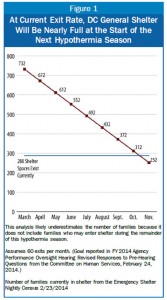Last week, DCFPI raised concerns that the Mayor’s plan to address the homeless crisis focused too heavily on diverting families seeking shelter, because it could have left many families in harm’s way and would have done little to address the more than 730 families currently living in emergency shelter. Yesterday, Gray administration officials told the DC Council that they would not be asking for a vote on that emergency legislation next week. That is a positive development.
With the issue of shelter diversion set aside for now, the Administration should focus on moving forward quickly to implement other components of its plan that will help move families into stable housing with the supports they need to get back on their feet. Unless the Gray Administration takes greater action now, we are likely to repeat the same crisis next year.
Our current crisis partly reflects the fact that the city’s main emergency shelter, the run-down DC General Hospital Complex, was nearly full when this winter began. The mayor should aim to reduce the number of homeless families in shelter to well below 280, the current capacity at DC General, by next fall. That will make it easier to absorb the inevitable increase in homeless families that will occur next winter.
Mayor Gray recently announced a plan to help move families out of shelter and into stable housing. These actions hold promise and should be acted on urgently. Mayor Gray also should consider further steps to increase the success of these efforts:
- Speed up housing placements. The District should strive to move at least 100 families out of shelter per month, an increase from the rate of 40 to 60 in
 recent months. At the current rate, the DC General Shelter will still be nearly full next winter (see Figure 1), while increasing the rate of exits to 100 per month would leave that shelter nearly empty by then. Achieving this increase requires significant outreach to private landlords and expansion of DC’s capacity to identify and inspect housing units, both of which are included in the mayor’s plan. But it will take more than that to get to move 100 families out of shelter per month. For example, DC should consider offering one-time incentives to landlords for leasing up quickly and utilizing a high-profile communications campaign to identify new landlords who may be available to assist.
recent months. At the current rate, the DC General Shelter will still be nearly full next winter (see Figure 1), while increasing the rate of exits to 100 per month would leave that shelter nearly empty by then. Achieving this increase requires significant outreach to private landlords and expansion of DC’s capacity to identify and inspect housing units, both of which are included in the mayor’s plan. But it will take more than that to get to move 100 families out of shelter per month. For example, DC should consider offering one-time incentives to landlords for leasing up quickly and utilizing a high-profile communications campaign to identify new landlords who may be available to assist. - Build staff capacity, particularly around the rapid re-housing program. The District aims to serve approximately 80 percent of homeless families with rapid re-housing, a program that moves families out of shelter quickly and into housing with temporary subsidies and social supports, but there are not sufficient dedicated staff to run it and sufficient training to help ensure all providers are implementing best practices. Moving forward with the mayor’s plan to hire three additional staff to manage the program as well as expanding training for all housing providers is critical.
DC also needs to increase funding for, and immediately move families into, Permanent Supportive Housing (PSH), which is a housing-first model of providing both permanent housing and wrap-around services to those who have been chronically homeless. Forty-five families have been assessed as in need of PSH, and it’s estimated that up to 30 more families may be in need of PSH. However, the FY 2014 budget only includes 20 slots for families and it seems that no families have been moved into these slots yet. DC must immediately move identified families into these slots and identify the funding to serve the remaining families in need.
It also is critical that DC urgently move forward on the mayor’s plan to increase resources for affordable housing and target a portion of those resources on homeless families. Rapid re-housing depends on the fact that there are a sufficient number of low-cost units for families to move into. After all, a lack of affordable housing options is at the crux of this crisis. By focusing on these steps–and working on strategies that help prevent families from needing shelter in a way that doesn’t harm their safety or stability–the District can exit families more quickly, help families reestablish their lives in the community, and create much-needed vacancies for other families in need of emergency shelter. This will allow the District to start next winter on the right foot.
To print a copy of today’s blog, click here.
